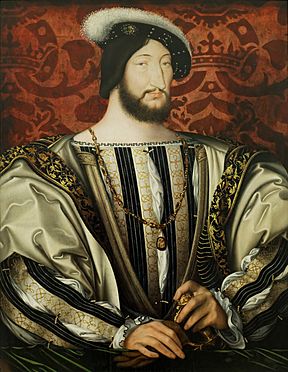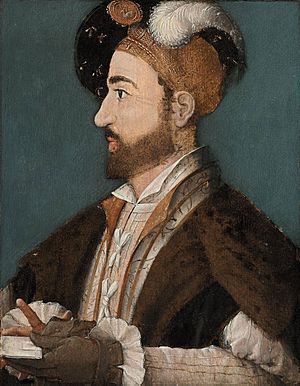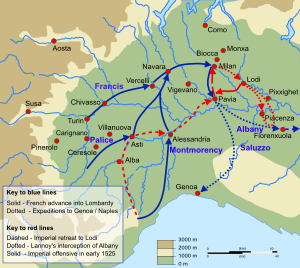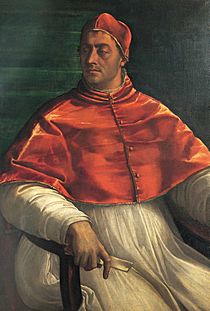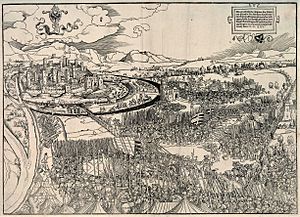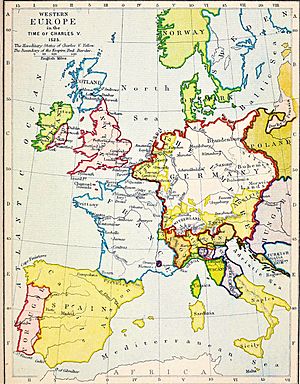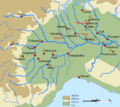Italian War of 1521–1526 facts for kids
Quick facts for kids Italian War of 1521–1526 |
|||||||
|---|---|---|---|---|---|---|---|
| Part of the Italian Wars | |||||||
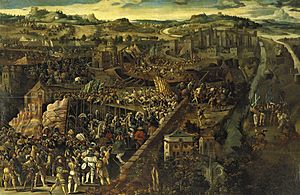 The Battle of Pavia, by an unknown Flemish artist |
|||||||
|
|||||||
| Belligerents | |||||||
|
|
|||||||
| Commanders and leaders | |||||||
The Italian War of 1521–1526, also called the Four Years' War, was a big conflict in Europe. It was part of the larger Italian Wars. This war was fought between Francis I of France and his allies, like the Republic of Venice, against Charles V, who was the Holy Roman Emperor and King of Spain. Henry VIII of England and the Papal States (the Pope's lands) also joined Charles V.
The war started because Francis I and Charles V both wanted to be the most powerful ruler in Europe. They especially disagreed over who should be the Holy Roman Emperor. The Pope also joined Charles V because he wanted help dealing with new religious ideas spreading across Europe.
Fighting began in late 1521. French forces tried to take back Navarre in Spain. Another French army invaded the Low Countries (modern-day Belgium and Netherlands). Spanish forces pushed the Navarrese back. Other armies loyal to the Emperor attacked northern France, but they were stopped.
In 1521, Charles V and Henry VIII secretly agreed to fight France. The war then moved to Italy. At the Battle of Bicocca in April 1522, Charles V's and the Pope's armies defeated the French. This forced the French out of Lombardy, a rich region in Italy. After this, Venice made a separate peace deal.
In 1523, England openly joined the war and invaded France. A French military leader, Charles de Bourbon, felt unfairly treated by Francis I. He switched sides and allied with the Emperor. A French attempt to take back Lombardy in 1524 failed. This gave Bourbon a chance to invade Provence in southern France with a Spanish army.
Francis I led a second attack on Milan in 1525. This led to a terrible defeat at the Battle of Pavia. Francis I was captured by the Emperor's captain, Charles de Lannoy. Many of his important nobles were killed. This battle effectively ended the war.
Francis I was held prisoner, first in Italy, then in Madrid, Spain. His mother, Louise of Savoy, tried hard to get him released. She even sent a mission to Suleiman the Magnificent, the powerful ruler of the Ottoman Empire. This was unusual because Christian and Muslim rulers usually didn't team up. Suleiman invaded Hungary in 1526, which helped put pressure on Charles V.
Despite these efforts, Francis I had to sign the Treaty of Madrid. In this treaty, he gave up his claims to lands in Italy, Artois, Flanders, and Burgundy. A few weeks after he was released, Francis I broke his promise and started a new war, the War of the League of Cognac. The Italian Wars continued for another 30 years. France never managed to get back much land in Italy.
Contents
Why the War Started
After a peace treaty in London in 1518, the main European powers seemed friendly. These powers included France, England, Spain, and the Holy Roman Empire. But they disagreed about who would become the next Holy Roman Emperor.
The current Emperor, Maximilian I, wanted his grandson, Charles I of Spain, to take his place. But Francis I of France also wanted to be Emperor. The Pope was worried about Spanish troops being close to the Vatican. So, he supported Francis I at first.
Maximilian died in January 1519. This made the election for Emperor very important. Most of the electors (princes who voted for the Emperor) took large sums of money from Charles V to vote for him. Francis I also offered a lot of money. But in the end, the electors chose Charles V. He became Holy Roman Emperor in October 1520. By then, he already ruled Spain and lands in the Low Countries.
In 1521, England tried to help Spain and France settle their differences. Henry VIII met with Charles V. Henry and Francis I also had a very fancy meeting called the Field of the Cloth of Gold. But these meetings did not stop the fighting.
Charles V was busy dealing with Martin Luther, who had new religious ideas. The Pope, Leo X, wanted to stop Luther. He saw Charles V as a possible ally. In May 1521, Charles V spoke out against Luther. He also helped the Pope get back some Italian cities. The Pope then promised to help Charles V push the French out of Lombardy. This left Francis I with only Venice as an ally.
Early Fighting (1521–1522)
In August 1521, Charles V's army invaded northeastern France. They attacked towns like Ardres and Mouzon. They also sacked Aubenton. The French, led by Pierre Terrail, seigneur de Bayard, bravely defended Mézières for three weeks. This gave Francis I time to gather a large army. Charles V's forces had to retreat.
Tournai, a city that Henry VIII had given back to France, was attacked by Charles V's forces. Francis I's army had to retreat and was later disbanded. So, Tournai surrendered.
French and Navarrese forces also captured the fortress of Amaiur in Spain. They later took Fuenterrabia on the border. The French held this important spot in northern Spain until March 1524.
In November 1521, Charles V and Henry VIII secretly signed the Treaty of Bruges. This treaty was against France. Odet de Foix, Vicomte de Lautrec, the French governor of Milan, tried to stop Charles V's and the Pope's armies. But he was pushed out of Milan. His army was joined by Swiss mercenaries. But Lautrec could not pay them, so they demanded to fight immediately.
On April 27, 1522, Lautrec attacked the combined Imperial and Papal army at the Battle of Bicocca. The Swiss soldiers charged too early. They were badly beaten by Spanish soldiers with arquebuses (early firearms) and German mercenaries. The Swiss soldiers lost heart and went home. This meant the French lost Lombardy. Charles V's forces then captured Genoa in May.
France Under Pressure
After losing Lombardy, England officially declared war on France in May 1522. Henry VIII and Charles V signed the Treaty of Windsor in June 1522. This treaty planned a joint English and Imperial attack on France. Charles V agreed to pay England for money it would lose by fighting France. He also agreed to marry Henry's daughter, Mary. In July, the English raided Morlaix. In September, an English army marched from Calais, burning and looting.
To get more money for the war, Francis I started a legal case against Charles III, Duke of Bourbon. Bourbon was a powerful French leader who had inherited much land from his wife. After his wife died, Francis I's mother, Louise of Savoy, claimed the lands for herself. Francis I began taking parts of Bourbon's lands. Bourbon was very angry. He secretly started talking to Charles V.
The leader of Venice, Antonio Grimani, died. Andrea Gritti became the new leader. He quickly made a peace deal with Charles V in July 1523. This took Venice out of the war. Bourbon continued his secret plans with Charles V. He offered to start a rebellion against Francis I if he got money and German troops. Francis I found out about the plot. Bourbon then openly joined Charles V.
Charles V then invaded southern France from the Pyrenees mountains. The French successfully defended Bayonne. But Charles V recaptured Fuenterrabia in February 1524. In September 1523, an English army advanced from Calais into France. The French army was spread thin and could not stop them. The English army got within 80 kilometres (50 mi) of Paris. But Charles V did not support the English attack. So, the English army turned back in October.
Francis I then focused on Lombardy again. In September 1523, a French army advanced into Italy. The Imperial commander, Prospero Colonna, had only 9,000 men. He had to retreat to Milan. The French commander, Bonnivet, thought the Imperial army was bigger than it was. He decided to wait for winter instead of attacking Milan. This gave Charles V's commanders time to gather more troops. Many Swiss soldiers left the French army. Bonnivet began to retreat. The French were defeated at the Battle of the Sesia. Bayard, a brave French knight, was killed. The French army retreated over the Alps in disarray.
Charles V's commanders, d'Avalos and Bourbon, then invaded Provence in southern France in July 1524. They captured most towns easily. Bourbon entered Aix-en-Provence and promised to support Henry VIII against Francis I. By mid-August, Bourbon and d'Avalos attacked Marseille, the only French stronghold left in Provence. But their attacks failed. When Francis I's army arrived in September, they had to retreat back to Italy.
Francis I's Italian Campaign (1524–1525)
French March into Lombardy
In October 1524, Francis I crossed the Alps with an army of over 40,000 men. Charles V's troops were tired from fighting in Provence. They could not stop the French.
The Imperial commander in Milan decided he could not defend the city. The city also had the plague. So, on October 26, he moved his troops out of Milan. Francis I's army entered Milan as the Imperial troops left.
Francis I put Louis II de la Trémoille in charge of Milan. Against the advice of his other commanders, Francis I then marched his army to Pavia. Antonio de Leyva was there with a strong group of soldiers. The main French army arrived at Pavia on October 24.
The Siege of Pavia
By November 2, the French army had surrounded Pavia. Inside the city were about 9,000 soldiers. Their commander, Antonio de Leyva, had to melt down church treasures to pay them. The French started bombing Pavia on November 6. On November 21, Francis I tried to attack the city, but he was pushed back with many losses. Because of bad weather and not enough gunpowder, the French decided to wait for the defenders to run out of food.

In December, a Spanish force landed near Genoa. Francis I sent a larger French force to stop them. The Spanish soldiers surrendered.
In January 1525, Charles V's army got more soldiers. They were able to attack again. They cut off the French supply lines between Pavia and Milan. On January 25, the main Imperial army marched to Pavia.
In February, the French position became weaker. Many German and Swiss mercenary soldiers left the French army. Francis I's army was camped outside Pavia, between the city's defenders and the approaching Imperial army. There were small fights throughout February.
Albany's March Towards Naples
After peace talks failed, Francis I and Pope Clement VII secretly made an alliance. This happened on January 5, 1525. The Pope promised not to help Charles V. In return, Francis I would help the Pope conquer Naples. Francis I also promised to give the Pope some lands.
Against the Pope's advice, Francis I sent part of his army south. This force, led by the Duke of Albany, was meant to help the Pope invade Naples. The army grew as more soldiers joined them.
Francis I hoped this would make the Spanish army leave northern Italy. But the Imperial commanders decided to focus on helping Pavia instead.
The Battle of Pavia
On the night of February 23, Charles V's army began to attack. They quietly broke down part of the park wall where the French were camped. Imperial soldiers then entered the park.
At the same time, the soldiers inside Pavia attacked. In the four-hour battle, the French cavalry charged quickly. This blocked their own cannons. They were then surrounded by German and Spanish soldiers hiding in the woods. The French knights, wearing heavy armor, were easily shot down. The French and Swiss foot soldiers were also defeated.
The French army suffered huge losses. Many important leaders were killed or captured. Francis I himself was taken prisoner.
After the Battle (1525–1526)
After the Battle of Pavia, Francis I sent a letter to his mother. He wrote that he had lost everything "save honour and life." The remaining French soldiers retreated back to France.
What would happen to Francis I and France became a big topic for diplomats. Charles V needed money for the war. He wanted to marry Isabella of Portugal, who had a large dowry. Meanwhile, Bourbon planned with Henry VIII to invade and divide France.
Louise of Savoy, Francis I's mother, raised a small army to defend France. She also sent a mission to Suleiman the Magnificent of the Ottoman Empire. She asked for help to free Francis I. In December 1525, a second mission reached Constantinople. Suleiman sent a reply, but it did not promise much.
Francis I's captors were worried he might be rescued or escape. They decided to move him. Francis I believed he would be freed if he met Charles V in person. So, he was taken by ship to Spain. He arrived in Barcelona in June 1525.
Francis I was held in different castles. Charles V ordered him to be imprisoned in Madrid. Charles V did not want to meet Francis I in person. Meanwhile, Henry II of Navarre, who had fought with Francis I at Pavia, escaped from prison in December 1525.
The Treaty of Madrid (1526)
Charles V demanded that Francis I give up not only Lombardy but also Burgundy and Provence. Francis I argued that French law did not allow him to give away lands belonging to the crown. By early 1526, Charles V was facing demands from Venice and the Pope. They wanted him to restore Francesco II Sforza to power in Milan. Charles V wanted to make a deal with the French before another war started.
Francis I was ready to give up Burgundy to be released. On January 14, 1526, Charles V and Francis I signed the Treaty of Madrid. Francis I gave up all his claims in Italy, Artois, and Flanders. He gave Burgundy to Charles V. He also agreed to send two of his sons to be hostages in Spain. He promised to give Bourbon back his lands. He also agreed to marry Charles V's sister, Eleanor.
After the Treaty
Francis I was released on March 6. On March 17, he crossed back into France. At the same time, his two sons went into Spain as hostages. Francis I had also made peace with England in a treaty signed in August 1526.
Pope Clement VII became worried about Charles V's growing power in Italy. Envoys from Venice and the Pope suggested an alliance against Charles V to Francis I. Francis I never planned to keep his promises from the Treaty of Madrid. On May 10, 1526, his royal council decided to break the treaty. They said he was forced to sign it while he was a prisoner.
In June 1526, Francis I and the Pope, along with cities in northern Italy like Milan, Venice, Florence, and Genoa, started the War of the League of Cognac. They tried to get back the land France had lost. Henry VIII was named the 'protector' of this group, but he did not officially join.
Francis I and his son, Henry II, continued to claim lands in Milan for many years. They only gave up these claims after the Peace of Cateau-Cambrésis in 1559. France did not get back any of its former lands in Lombardy. The peace treaty that ended the Italian Wars gave Spain control of Milan, Naples, Sicily, Sardinia, Savoy, and Piedmont.
Images for kids
See also
 In Spanish: Guerra italiana de 1521-1526 para niños
In Spanish: Guerra italiana de 1521-1526 para niños


